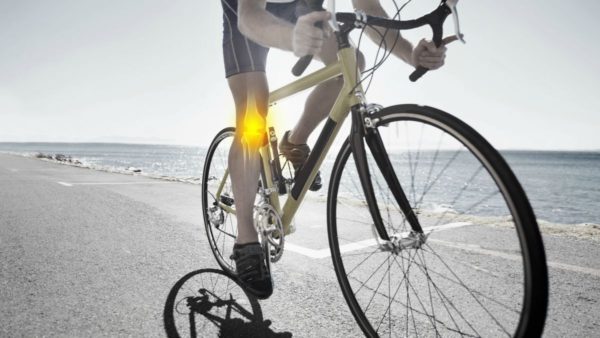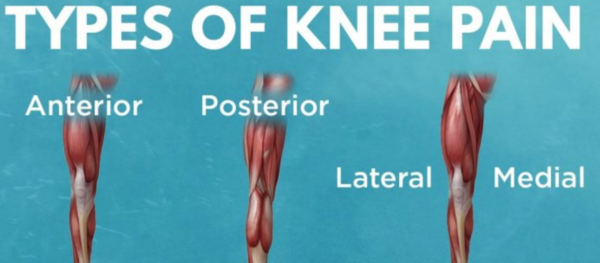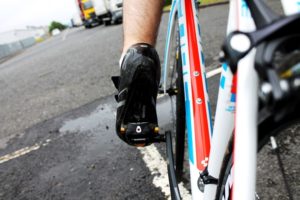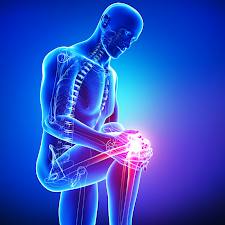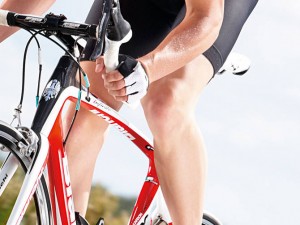The two main areas that cause cyclists the most headache are the lower back and the knee. Ride long enough and you are almost guaranteed to experience some sort of pain, discomfort or injury in one or both of these parts of the body. Today we are going to focus on the knee, why cycling knee pain occurs, and what we can do to prevent it from happening.
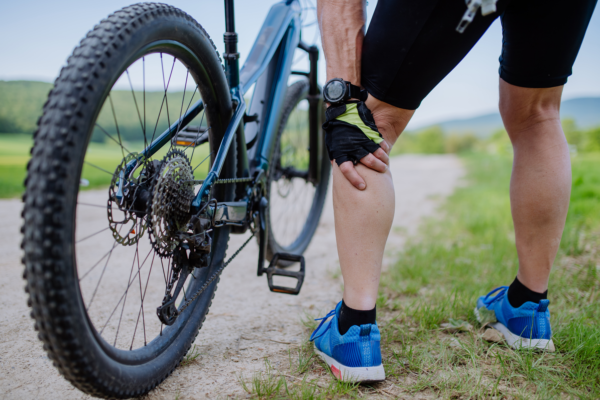
Halfpoint/Adobe Stock
When a particular sensation is prevalent amongst athletes participating in the same sport, it can be tempting to throw the baby out with the bath water and think that the sport itself is the problem. Take running for example. A large percentage of the population believes running is bad for the human body, when in fact the evidence supports an entirely opposite hypothesis, that human beings are actually the best and most efficient runners in the animal kingdom.
Cycling also carries some of these stereotypes.
Because so many cyclists have knee problems, the conclusion must be that cycling is bad for your knees – right? We don’t think so. In our view, the fact that it’s a commonly experienced problem simply means that most people’s knees are not prepared to do the work that they’re doing on the bike, and/or perhaps are doing that work improperly.
Just like running, everybody thinks riding a bike is just riding a bike. Something you learned when you were a kid and kept with you for the rest of your life. How could you mess it up? But they fail to consider the differences between these two time periods. The truth is cycling as an adult is far different from riding your bike as a kid, and our bodies are quick to remind us of that through the telltale signs of pain and injury.
Let us consider these differences, and take into account everyone from beginners to professionals, by analyzing some of the causes of knee pain from cycling.
Increasing Volume Too Quickly
A classic mistake of anybody entering into a sport or trying to regain their fitness after injury is doing too much too soon. It doesn’t help that many people are recommended or even prescribed cycling as an activity that is low impact that they can do despite their lack of overall strength, health and wellness (this is the case for several elderly people, for example).
Our sport is indeed a great way for people to get their health in check, but that doesn’t mean its unique demands on the body can be disregarded and instantly capitalized upon. You have to earn a healthy body, and the price is not small. Going from zero to 50 miles a week on your new road rig is an approach that is going to humble you very quickly.
The knees are uniquely positioned to cause you agony in this scenario. Because of the tremendous forces produced by our quadriceps (front thigh muscles) while pedaling, and our position on the bike in general, the knee joint is susceptible to the bulk of those loads being constantly transferred across it. If it has not had the time to slowly adapt to such loads, you could be in for a painful awakening.
Cyclist’s knee is a broad term used for conditions such as patellofemoral pain syndrome, patellar compression syndrome, patellar tendinitis, and a host of other names that are describing pain on the front of the knee, just below or above the kneecap, and even inside the knee joint itself. Often increasing with use and subsiding with rest.
It is outside the scope of this article to go into each of these with detail, but it should be noted that they can all be exacerbated by an unprepared knee that the athlete is asking too much of in their training. Like any sport, jumping on the bike is going to have you using your muscles in new ways you’re not used to. You have to give the body time to adapt to these new demands, by slowly and thoughtfully increasing training volume when it is ready to do so.
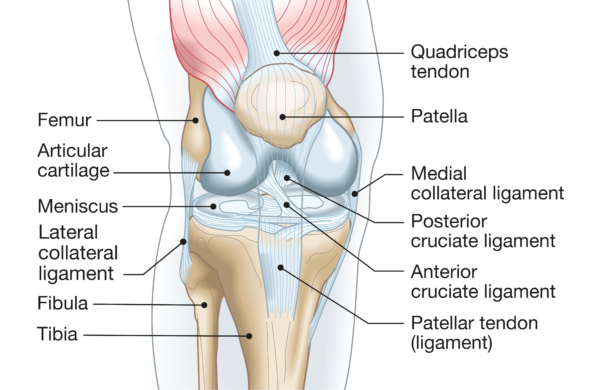
Axel Kock/Adobe Stock
Weak Hips
A sport can be looked at as a more advanced level of physical activity, just like going to university is a more advanced level of education. To get into university, there are prerequisites; the attainment of certain grades or passing of certain exams, for example. In sports, there are also prerequisites, we just don’t usually consider them before participating.
One of these prerequisites for a new or current cyclist should be having strong hips. Having strong hips not only stabilizes the pelvis and contributes greatly to the overall function of the body, it also helps keep the knees in good alignment. Strong hips are not going to develop on the bike, however, adding to the importance of this particular tip.
Hip abduction (moving the leg away from the midline) and hip extension (moving the leg behind you) are severely limited when cycling. The saddle immobilizes the pelvis, and the degree to which your hips flex and extend is nowhere near their full range of motion. This, played out over a long enough period of time, is likely to get us hurt.
When doing a squat, for example, one of the functions of your glute (butt) muscles is to keep your knees from collapsing inward. In fact, a common cue when having someone squat is telling them, “push your knees out”, this activates the gluteals and helps you maintain balance and activation in the hips when squatting. If you see a person’s knees falling inwards during a light-moderate intensity squat, they likely have weakness in their hips.
Why does this matter for cyclists? If you have weak hips, your knee is likely collapsing inward while you pedal. This is a problem, because you are going to further exacerbate this imbalance the more you ride your bike, and this can lead to your muscles developing improperly, pulling structures like your patella (kneecap) out of alignment.
Supplementing your time on the bike with a balanced strength and conditioning program is going to help ensure that you maintain balance throughout your body, and reduce the chances of your cycling causing knee pain down the line.
Rido/Adobe Stock
Saddle Height
Your bike fit can have a tremendous amount of influence over how your body feels and functions while riding. The saddle height in particular can be a culprit when it comes to cycling knee pain, because the loads on, and angles of, your knee are going to be different depending on where your seat is positioned.
Having a seat that is too low is going to be the most detrimental when it comes to developing pain in the front, sides and inside the knee. This is because it’s going to keep your knee in a more bent position throughout the whole pedal stroke, and you’re going to be pushing from a mechanically disadvantaged position that puts huge force right through the knee joint. This also leads to quicker fatigue and overall breakdown of form in the athlete.
Having your seat too high isn’t good either, however, because now you’re going to be at risk of hyperextending the leg, and putting excessive strain on the internal ligaments of the knee (ACL/PCL) as well as the hamstring tendons and calf musculature in the back of your leg. The lower leg will also take more load than necessary, putting tissues like the achilles tendon at risk of developing further problems.
A correct saddle height will leave you with a slightly bent knee at the 6 o’clock pedal position. If you straighten your leg in this position your heel would drop 1-2 cm below the pedal. This position keeps the knee stable, and allows enough extension to properly utilize the force of the quadriceps, hamstrings and lower leg, but not too much to overextend and strain the ligaments of the knee.
Knee Rehab Program for Cyclists
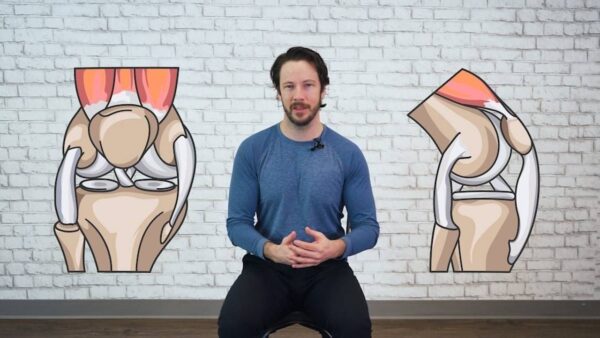
Looking for a program that will help you address the muscle imbalance that is likely causing your knee pain? Dynamic Cyclist is an online training platform designed to help cyclists become stronger and faster while riding pain free for years to come. Complete your regimen with an all-inclusive program that addresses mobility, flexibility, strength and injury prevention, all for a fraction of the cost of one physiotherapy appointment. Try out their 6 Week Functional Rehab Program and experience the results for yourself. Click here to try 7 days free!
